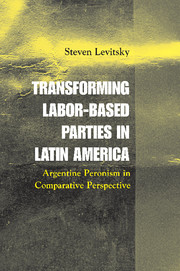Book contents
- Frontmatter
- Contents
- Figure and Tables
- Acknowledgments
- 1 Labor-Based Party Adaptation in the Neoliberal Era: Rethinking the Role of Party Organization
- 2 Origins and Evolution of a Mass Populist Party
- 3 An “Organized Disorganization”: The Peronist Party Structure in the 1990s
- 4 Populism in Crisis: Environmental Change and Party Failure, 1983–1985
- 5 From Labor Politics to Machine Politics: The Transformation of the Peronist Party–Union Linkage
- 6 Menemism and Neoliberalism: Programmatic Adaptation in the 1990s
- 7 A View from Below: Party Activists and the Transformation of Base-Level Peronism
- 8 The Paradox of Menemism: Party Adaptation and Regime Stability in the 1990s
- 9 Crisis, Party Adaptation, and Democracy: Argentina in Comparative Perspective
- References
- Index
4 - Populism in Crisis: Environmental Change and Party Failure, 1983–1985
Published online by Cambridge University Press: 22 December 2009
- Frontmatter
- Contents
- Figure and Tables
- Acknowledgments
- 1 Labor-Based Party Adaptation in the Neoliberal Era: Rethinking the Role of Party Organization
- 2 Origins and Evolution of a Mass Populist Party
- 3 An “Organized Disorganization”: The Peronist Party Structure in the 1990s
- 4 Populism in Crisis: Environmental Change and Party Failure, 1983–1985
- 5 From Labor Politics to Machine Politics: The Transformation of the Peronist Party–Union Linkage
- 6 Menemism and Neoliberalism: Programmatic Adaptation in the 1990s
- 7 A View from Below: Party Activists and the Transformation of Base-Level Peronism
- 8 The Paradox of Menemism: Party Adaptation and Regime Stability in the 1990s
- 9 Crisis, Party Adaptation, and Democracy: Argentina in Comparative Perspective
- References
- Index
Summary
On the evening of October 30, 1983, as the polls closed on the first election of Argentina's new democratic era, Peronists who gathered at the party headquarters were in a state of shock. Anxious party leaders repeatedly asked one another the same question: “When do the votes from the industrial belt come in?” It soon became clear that those votes would not arrive, and that for the first time in its history, the PJ would lose a free election. The election night scene highlights one of two environmental challenges that Peronism confronted during the 1980s. Changes in Argentina's social structure had eroded the PJ's industrial working-class base, weakening the unions that had traditionally linked the party to its urban base and creating new groups of voters with weaker ties to the Peronist organization and subculture. Over the course of the decade, changing economic conditions presented the PJ with a second challenge: The debt crisis and the collapse of the inward-oriented economic model fundamentally altered national policy-making parameters, limiting the viability of the traditional Peronist program. The PJ's survival as a major political force hinged on its capacity to adapt to these environmental changes.
This chapter examines the electoral and economic challenges that confronted the PJ in the 1980s, as well as the strategic choices that party leaders faced in responding to them. It begins with a brief description of the PJ coalition and program at the outset of the contemporary period.
- Type
- Chapter
- Information
- Transforming Labor-Based Parties in Latin AmericaArgentine Peronism in Comparative Perspective, pp. 91 - 106Publisher: Cambridge University PressPrint publication year: 2003



